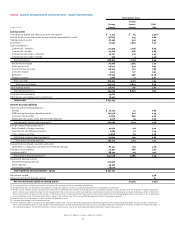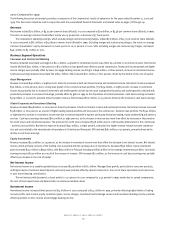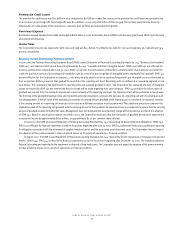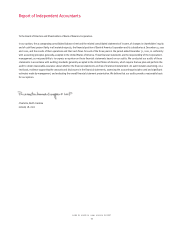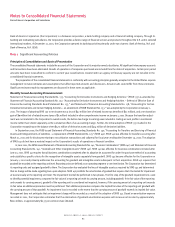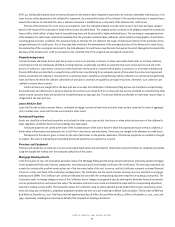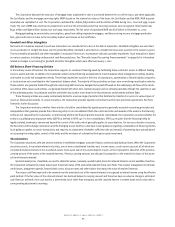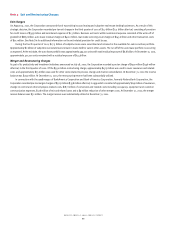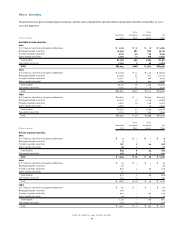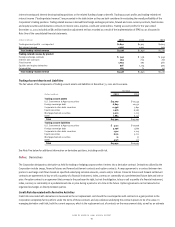Bank of America 2001 Annual Report Download - page 84
Download and view the complete annual report
Please find page 84 of the 2001 Bank of America annual report below. You can navigate through the pages in the report by either clicking on the pages listed below, or by using the keyword search tool below to find specific information within the annual report.
BANK OF AMERICA 2001 ANNUAL REPORT
82
Bank of America Corporation (the Corporation) is a Delaware corporation, a bank holding company and a financial holding company. Through its
banking and nonbanking subsidiaries, the Corporation provides a diverse range of financial services and products throughout the U.S. and in selected
international markets. At December 31, 2001, the Corporation operated its banking activities primarily under two charters: Bank of America, N.A. and
Bank of America, N.A. (USA).
Note 1 Significant Accounting Policies
Principles of Consolidation and Basis of Presentation
The consolidated financial statements include the accounts of the Corporation and its majority-owned subsidiaries. All significant intercompany accounts
and transactions have been eliminated. Results of operations of companies purchased are included from the dates of acquisition. Certain prior period
amounts have been reclassified to conform to current year classifications. Assets held in an agency or fiduciary capacity are not included in the
consolidated financial statements.
The preparation of the consolidated financial statements in conformity with accounting principles generally accepted in the United States requires
management to make estimates and assumptions that affect reported amounts and disclosures. Actual results could differ from those estimates.
Significant estimates made by management are discussed in these notes as applicable.
Recently Issued Accounting Pronouncements
Statement of Financial Accounting Standards No. 133, “Accounting for Derivative Instruments and Hedging Activities,” (SFAS 133) as amended by
Statement of Financial Accounting Standards No. 137, “Accounting for Derivative Instruments and Hedging Activities – Deferral of Effective Date of
Financial Accounting Standards Board Statement No. 133,” and Statement of Financial Accounting Standards No. 138, “Accounting for Certain
Derivative Instruments and Certain Hedging Activities – an amendment of FASB Statement No. 133,” was adopted by the Corporation on January 1,
2001. The impact of adopting SFAS 133 to net income was a loss of $52 million (net of related income tax benefits of $31 million), and a net transition
gain of $9 million (net of related income taxes of $5 million) included in other comprehensive income on January 1, 2001. Because the transition adjust-
ment was not material to the Corporation’s overall results, the before-tax charge to earnings was included in trading account profits in noninterest
income rather than shown separately as the cumulative effect of an accounting change. Further, the initial adoption of SFAS 133 resulted in the
Corporation recognizing on the balance sheet $577 million of derivative assets and $514 million of derivative liabilities.
In September 2000, the FASB issued Statement of Financial Accounting Standards No. 140, “Accounting for Transfers and Servicing of Financial
Assets and Extinguishments of Liabilities – a replacement of FASB Statement No. 125” (SFAS 140). SFAS 140 was effective for transfers occurring after
March 31, 2001 and for disclosures relating to securitization transactions and collateral for fiscal years ending after December 15, 2000. The adoption
of SFAS 140 did not have a material impact on the Corporation’s results of operations or financial condition.
In June 2001, the FASB issued Statement of Financial Accounting Standards No. 141, “Business Combinations” (SFAS 141) and Statement of Financial
Accounting Standards No. 142, “Goodwill and Other Intangible Assets” (SFAS 142). SFAS 141 was effective for business combinations initiated after
June 30, 2001. SFAS 141 requires that all business combinations completed after its adoption be accounted for under the purchase method of accounting
and establishes specific criteria for the recognition of intangible assets separately from goodwill. SFAS 142 became effective for the Corporation on
January 1, 2002 and primarily addresses the accounting for goodwill and intangible assets subsequent to their acquisition. SFAS 142 requires that
goodwill be recorded at the reporting unit level. Reporting units are defined as an operating segment or one level below. The Corporation has determined
its reporting units and assigned goodwill to them. The Corporation has evaluated the lives of intangible assets as required by SFAS 142 and determined
that no change will be made regarding lives upon adoption. SFAS 142 prohibits the amortization of goodwill but requires that it be tested for impairment
at least annually at the reporting unit level. The impairment test will be performed in two phases. The first step of the goodwill impairment test, used
to identify potential impairment, compares the fair value of a reporting unit with its carrying amount, including goodwill. If the fair value of the reporting
unit exceeds its carrying amount, goodwill of the reporting unit is considered not impaired; however, if the carrying amount of a reporting unit exceeds
its fair value an additional procedure must be performed. That additional procedure compares the implied fair value of the reporting unit goodwill with
the carrying amount of that goodwill. An impairment loss is recorded to the extent that the carrying amount of goodwill exceeds its implied fair value.
Management does not anticipate that an impairment charge will be recorded as a result of the adoption of SFAS 142. Based on amortization expense
recorded in 2001, the Corporation estimates that the elimination of goodwill amortization expense will increase net income by approximately
$600 million, or approximately $0.37 per common share (diluted).
Notes to Consolidated Financial Statements
Bank of America Corporation and Subsidiaries


